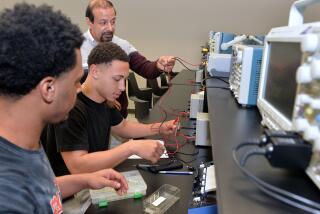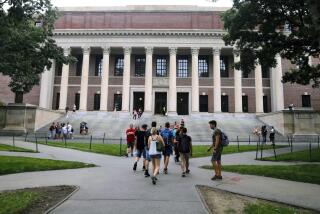College-Search Sites Can Be a Bit Trying
My daughter Katherine is starting her junior year of high school, which means it’s time to start looking at colleges. My wife Patt has already bought a shelf full of college guidebooks and is making travel plans to visit several campuses.
The other day, I decided to help with the search by using some of the cool new Internet sites designed to help students find and apply to a college and finance their education.
But when we started using the sites, we found them to be a mixed blessing.
These sites attempt to serve as a computer dating service that links students with colleges, filtering recommendations by region, academic quality, size of school, best values and lifestyle. Given the 4,000-plus universities in this country, these college-search sites face a daunting task to produce something insightful.
None of the sites I used deserved an A, and most of them had glaring weaknesses. Yet the exercise was valuable, because it helped the three of us think about the types of colleges that might be best for Katherine.
Each site has basically the same setup. You answer a series of questions to determine what you’re looking for in a college and what type of college your child might be qualified for. All of the sites we looked at are free. They all carry some sort of advertising along with special promotional offers such as student loans, credit cards and other buying opportunities.
My favorite of the bunch was Embark.com, which has a number of helpful features, including a tool for finding the right college, a scholarship search engine, information on financial aid and tips for getting into the college of your choice. For us, the most useful part is the college MatchMaker feature, which helps narrow your choices. You begin by selecting the regions of the country you might consider. Then you rate a series of options on a six-point scale from “very” interested to “not at all.”
My wife and I indicated a preference for a college with a small student body and answered questions about Katherine’s interest in sororities, specific sports, academic disciplines, student activities and other criteria. The process took us about 20 minutes. Coming up with answers was occasionally difficult, but that’s the whole idea. It forces you to think about what’s important.
When we were finished, the site came up with 200 potential schools, listed in the order of preferences based on the criteria we specified. The No. 1 choice, Oberlin College, was already high on my list of schools I think Katherine might like. I have no idea how the U.S. Naval Academy made the top 20, but most of the other schools that scored high seem to be reasonable candidates. I hadn’t heard of some of the schools on the list, which is a good thing, because it opened our eyes to other colleges.
There were some criteria the site didn’t ask about, such as proximity to a beach or lake, area weather conditions and whether the buildings are old or modern. These might not seem like weighty academic issues, but they can be important to a 17-year-old who is contemplating where she wants to spend four years of her life.
After my wife and I finished entering our criteria, Katherine sat down at the PC and filled out the questions herself. That turned out to be a real eye-opener for Patti and me because some of Katherine’s criteria were different from what we had expected.
She got a different list of schools, beginning with one I had never heard of--Furman University in Greenville, S.C. Other top contenders included Barnard College, Brandeis University, Trinity University and, for some reason, the U.S. Air Force Academy.
Clearly, many of the schools listed are unlikely candidates, but the process did help us narrow down our choices.
Overall, I’d give Embark.com a B plus.
CollegeLink.com, another leading site, gets a C minus.
CollegeLink has an advanced search that I found a lot more confusing than a similar one at Embark.com. Unlike Embark.com--where you rate each criterion on a scale of 1 to 6--CollegeLink lets you highlight only one option for each subject. So, when asked what size student body appeals to you, you’re forced to select only one option such as “less than 2,500 students” or “2,500-5,000 students.”
Worse, once we finished the process, the site couldn’t find any colleges that met our criteria, even though the same types of answers on Embark.com yielded 200 recommendations.
The only reason I’m not giving CollegeLink an F is because it does provide a useful quick glance at basic information such as location, number of students enrolled, competitiveness and tuition. (Embark.com also provides that information, but you have to dig a little deeper to find it.) CollegeLink also has some useful articles and basic information about loans and scholarships, but it’s generally uninspiring.
I also tried U.S. News and World Report’s Web site, which offers an annually updated ranking (https://www.usnews.com/usnews/edu/college) of what the magazine’s experts consider to be the best colleges in the country. One of my favorite features is its “best values” ranking--broken down by region and type of school--where students with grants can find the highest-rated schools that, after grants and discounts, will wind up costing them the least money.
The U.S. News’ college search engine was about as ineffective as CollegeLink’s, but its community college search tool worked just fine. I used it to locate two community colleges with a computer science major within 10 miles of my sister’s home in the San Fernando Valley.
I was also disappointed withPeterson’s (https://www.petersons.com), one of the oldest and most respected college information services in the country. But its CollegeQuest.com college search Web site failed the test when I tried the “personal counselor” that is advertised to “help you narrow your search to the schools that fit you perfectly.” The counselor was “temporarily unavailable” when I tried to use it, but I was encouraged to “please come back and visit this service soon.”
All of these services offer financial aid information, but Fastweb.com and Scholarships.comspecialize in matching students with potential scholarships. I liked Fastweb’s interview process better, but it’s worthwhile to go to both sites as each came up with different suggestions for funding based on a particular academic skill, ethnic group, sport, interest, religion or even parental occupation.
In addition to the general college advice services, virtually every college has its own Web site that provides detailed information on admission requirements, student life and academic programs. Many also offer a virtual tour of the campus as well as information about the surrounding community.
*
Technology reports by Lawrence J. Magid can be heard between 2 and 3 p.m. weekdays on the KNX-AM (1070) Technology Hour. He can be reached at [email protected]. His Web site is at https://www.larrysworld.com. Recent PC Focus columns are available at http://vinapk.com/pcfocus.






